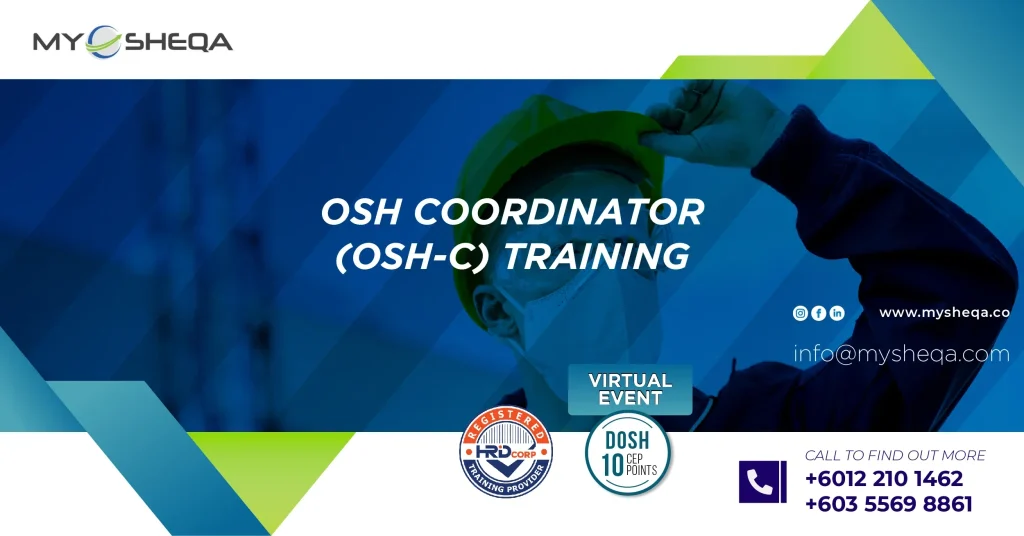OSH Coordinator Training
We, My SHEQA Group Sdn Bhd is one of the leading registered OSH Coordinator training provider (JKKP IKS/SBK 127/491/2-1) with Department of Occupational Safety and Health (DOSH) in Malaysia

Introduction
- Today, there are over one million SMEs employing seven million workers in Malaysia, making it increasingly difficult for the authorities to monitor the Occupational Safety and Health (OSH) requirements for each premises to ensure the safety and health at the workplace.
- Perhaps in correlation, the number of fatality cases from SMEs due to occupational accidents are also rising.
- Due to this, Department of Occupational Safety and Health, Ministry of Human Resource has taken the initiative to bring into existence the OSH Coordinator, a representative safety practitioner to self-regulate the safety and health provision of their premises.
- In addition, the “OSH Coordinator can be called OSHA Amendment 2022 Training” role is included into the Occupational Safety and Health (Amendment) Act 2022 in Section 29A, gazetted earlier this year requiring all employers that has “5 or more employees” to appoint an OSH Coordinator.
osh coordinator training Overview
This 3-day OSH Coordinator Training Program is designed to equip participants with a comprehensive knowledge on occupational safety and health and how to adopt OSH practices at the workplace on a daily basis. Upon the completion of this course, the participants will be certified as a “Trained Persons” that will be able to coordinate safety and health in preventing occupational accidents and diseases.
Course Objectives
- Explain the purpose, objective and importance of OSH Coordinator in an organization.
- Perform the role and duties of an OSH Coordinator in an organization.
- Demonstrate comprehensive knowledge and understanding of the requirements of Occupational Safety and Health Act 1994.
- Follow guidelines to manage and maintain the Occupational Safety and Health Documents.
- Nurture a healthy safety culture at the workplace.
Learning objectives
- Describe the Guidelines on Ergonomics Risk Assessment at Workplace 2017
- Understand the purpose and the benefits of the guidelines
- Apply a systematic plan and an objective approach in identifying, assessing and controlling ergonomics risk factors in the workplaces
- Write Initial Ergonomics Risk Assessment report
- Plan and Conduct Initial Ergonomics Risk Assessment
- Sharpen individual Speaking & Presentation skills
Who Should Attend?
- Safety and Health Committee Members.
- Human Resource Officers.
- Supervisors and Team Leaders from various sectors.
- Interested Individuals.
- Workers in small and medium enterprise (SME).
Certification
Participant will be received the Certificate of Attendance and highlighted as a trained person of OSH Coordinator at Department of Occupational Safety and Health (DOSH) website upon completion of training.
What do you need to be an OSH coordinator?
MODULE 1: REALITY OF SMALL AND MEDIUM INDUSTRIES IN MALAYSIA
a. Background, current situation, and categories of SMEs.
b. Challenges faced by SMEs business owners.
c. Incidents and types of injuries that have happened in the
industry.
d. The importance of OSH culture in workplace.
e. The characteristics, roles, requirements, and advantages of
appointing OSH-C.
MODULE 2: INTRODUCTION TO ROLE AND FUNCTION OF THE DEPARTMENT
a. Function and role of the Department.
b. History of OSH in Malaysia.
c. Main provisions of OSHA 1994 and FMA 1967.
d. Benefits of increasing the safety and health of employees for the
organization.
MODULE 3: BASIC MANAGEMENT OF OSH SMES
a. Employers’ obligation of forming the Safety and Health Regulation (OSH Coordinator Regulation).
b. Safety and Health Committee.
c. Notification of Accident.
d Preparation of Emergency Action Plan.
MODULE 4: CHEMICAL MANAGEMENT
a. Chemical Hazards.
b. Chemical Entry Route.
c. Elements of Chemical Management.
d. “Cradle to Grave” Concept.
MODULE 5: INTRODUCTION TO OCCUPATIONAL DISEASES
a. Introduction of DOSH Malaysia’s Occupational Health Section.
b. Introduction of Occupational Health.
c. Statistics of Occupational Disease in Malaysia.
MODULE 6: INTRODUCTION TO WORK-RELATED ROAD SAFETY
a. Road Accident Statistics (on the road accidents along with
roadside work-related incidents).
b. The status and impact of road accidents.
c. The importance of Work-Related Road Safety & Code of Practice for
Road Transport Activities, 2010.
d. The concept of driver, vehicle and journey management.
e. Overview of ISO 39001 dan ISO 39002.
f. Introduction to Management System and Road Safety Initiative.
MODULE 7: HAZARD IDENTIFICATION, RISK ASSESSMENT AND RISK
CONTROL
a. Definition of hazard, risk and danger.
b. Hazard identification method.
c. Risk analyzing process.
d. Risk analyzing matrix.
e. Control Hierarchy.
MODULE 7.1: PRACTICAL EXERCISE ON HIRARC
a. Definition of hazard, risk and danger.
b. Hazard identification method.
c. Group distribution.
d. HIRARC activities based on pictures that were provided and usage
of form.
e. Group discussion.
f. Presentation and Q&A session.
MODULE 8: MATERIAL STORAGE AND HANDLING
a. Interactive training – Moving orange / onion.
b. Managing and storing unplanned materials increases the risk of
accidents.
c. Examples of effective storing.
d. Use of manual and mechanical help tools.
e. Arrangement and storage at a workplace that adhere to the rules or
principles of WISE is under the legislation of OSH Malaysia.
MODULE 9: WORK STATION DESIGN & LIGHTING
a. Definition of workstation.
b. The best workstation design (increase productivity and reduce
ergonomic risk).
c. Interactive training – “Curve Tracking”.
d. Interactive training – “Seat Back”.
e. 4 principles of workstation design.
f. Adequate light increases productivity and work quality.
g. 3 principles of lighting.
h. Interactive training – “Exercise on Adequate Light”.
MODULE 10: PRODUCTIVE MACHINE SAFETY
a. Principle and types of guarding.
b. Types of ‘feeders’.
c. Types of “Holding Equipment”.
d. Applicable OSH law & legislation.
MODULE 11: REMISES AND WORK-RELATED FACILITIES
a. Basic methods of enhancing workplace environment.
b. Relationship between productivity and ideal workplace.
c. Benefits of welfare facilities.
d. Minimum cost of enhancing welfare facilities
